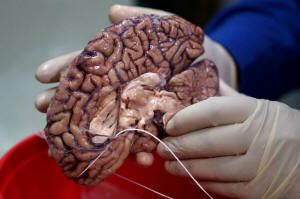|
Scientists hunt down genes behind
humankind's big brain
 Send a link to a friend
Send a link to a friend
 [June 01, 2018]
By Will Dunham [June 01, 2018]
By Will Dunham
WASHINGTON (Reuters) - Scientists have
pinpointed three genes that may have played a pivotal role in an
important milestone in human evolution: the striking increase in brain
size that facilitated cognitive advances that helped define what it
means to be human.
These genes, found only in people, appeared between 3 and 4 million
years ago, just prior to a period when the fossil record demonstrates a
dramatic brain enlargement in ancestral species in the human lineage,
researchers said on Thursday.
The three nearly identical genes, as well as a fourth nonfunctional one,
are called NOTCH2NL genes, arising from a gene family dating back
hundreds of millions of years and heavily involved in embryonic
development.

The NOTCH2NL genes are particularly active in the reservoir of neural
stem cells of the cerebral cortex, the brain's outer layer responsible
for the highest mental functions such as cognition, language, memory,
reasoning and consciousness. The genes were found to delay development
of cortical stem cells into neurons in the embryo, leading to the
production of a higher number of mature nerve cells in this brain
region.
"The cerebral cortex defines to a large extent what we are as a species
and who we are as individuals. Understanding how it emerged in evolution
is a fascinating question, touching at the basic origins of mankind,"
said developmental neurobiologist Pierre Vanderhaeghen of Université
Libre de Bruxelles and VIB/KULeuven in Belgium.
"It is the ultimate evolutionary question and it is thrilling to work in
this area of research," added biomolecular engineer David Haussler,
scientific director of the University of California, Santa Cruz Genomics
Institute and a Howard Hughes Medical Institute investigator.
[to top of second column]
|

A doctor holds a human brain in a brain bank in the Bronx borough of
New York City, New York, U.S. June 28, 2017. REUTERS/Carlo
Allegri/File Photo

The species Australopithecus afarensis, which combined ape-like and
human-like traits and included the well-known fossil dubbed "Lucy,"
lived in Africa at roughly the time these genes are estimated to
have appeared.
"It would be great if we could sequence Lucy's genome," said
UC-Santa Cruz biomolecular engineering research scientist Sofie
Salama, while noting the improbability of doing that.
The genes are absent in people's closest genetic relatives. None
were found in monkeys or orangutans. A nonfunctional cousin of these
genes was detected in gorillas and chimpanzees. But the researchers
found the genes in two extinct species in the human lineage,
Neanderthals and Denisovans.
NOTCH2NL gene abnormalities were found to be linked to neurological
conditions including autism, schizophrenia and both abnormally large
and abnormally small head size.
The findings on the NOTCH2NL genes were detailed in two studies
published in the journal Cell.
(Reporting by Will Dunham; Editing by Sandra Maler)
[© 2018 Thomson Reuters. All rights
reserved.]
Copyright 2018 Reuters. All rights reserved. This material may not be published,
broadcast, rewritten or redistributed.
Thompson Reuters is solely responsible for this content.
 |